选择性必修 第一册Unit 3 The art of paintingWelcome to the unit &Reading (I)精品课件 (共10张PPT)
文档属性
| 名称 | 选择性必修 第一册Unit 3 The art of paintingWelcome to the unit &Reading (I)精品课件 (共10张PPT) | 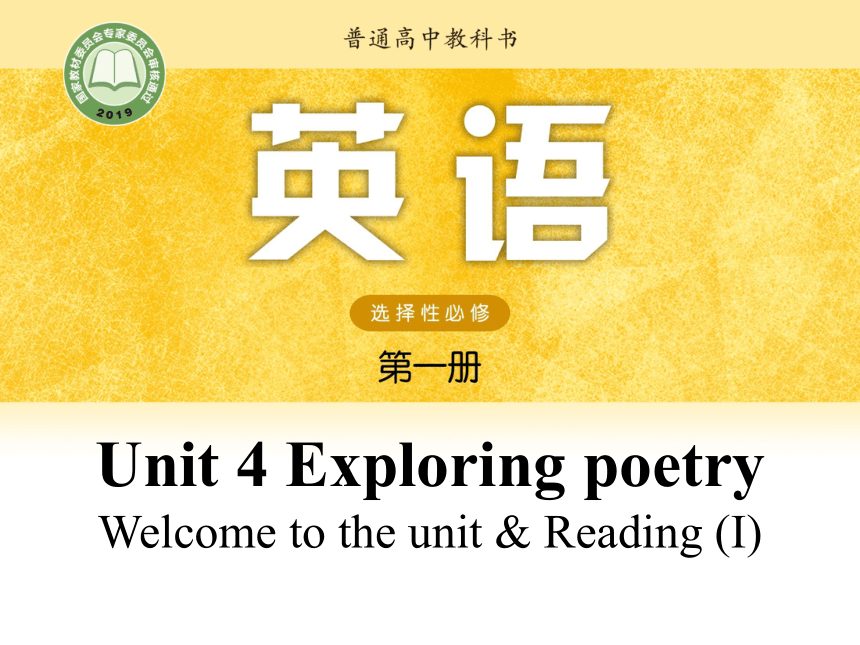 | |
| 格式 | pptx | ||
| 文件大小 | 1.5MB | ||
| 资源类型 | 教案 | ||
| 版本资源 | 牛津译林版(2019) | ||
| 科目 | 英语 | ||
| 更新时间 | 2023-03-30 16:32:58 | ||
图片预览

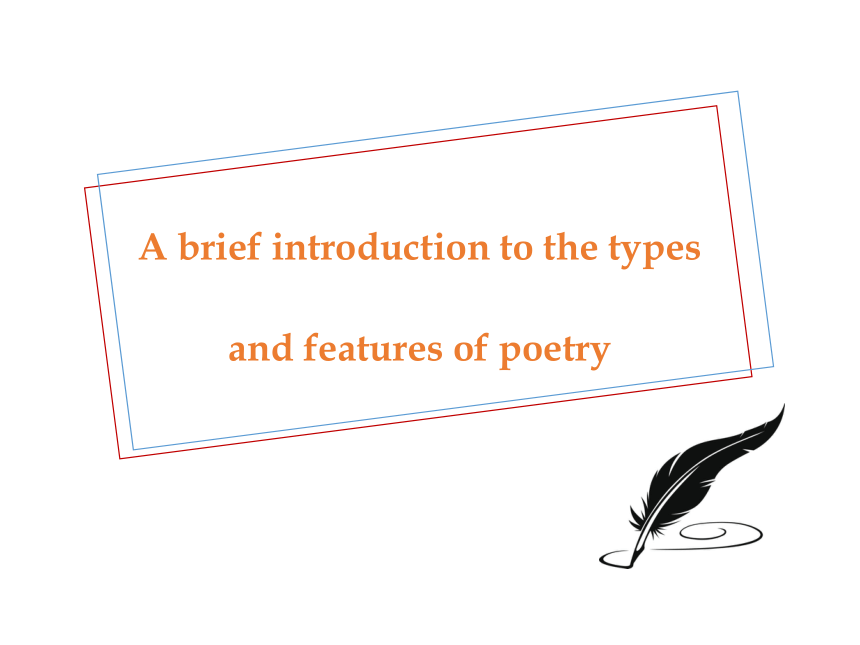
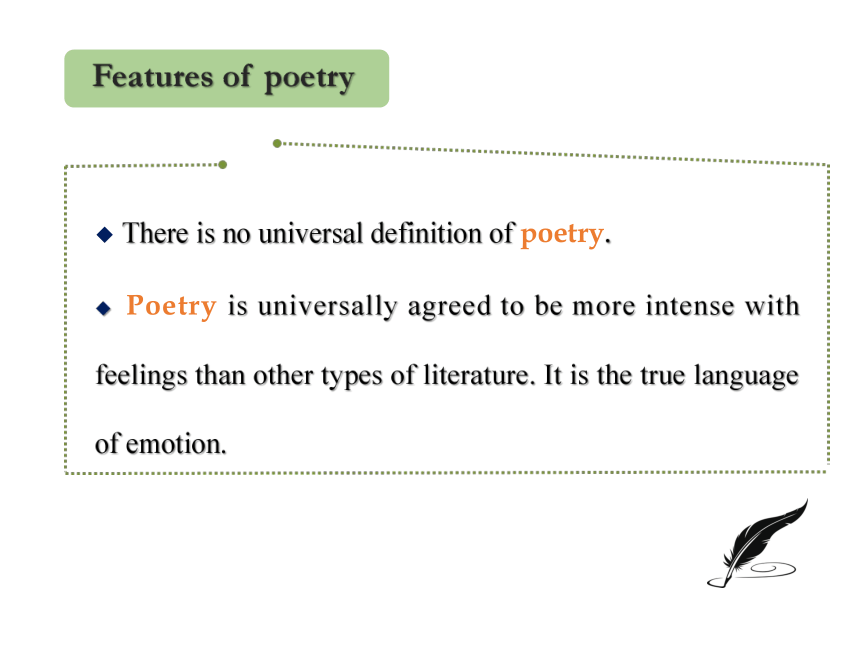
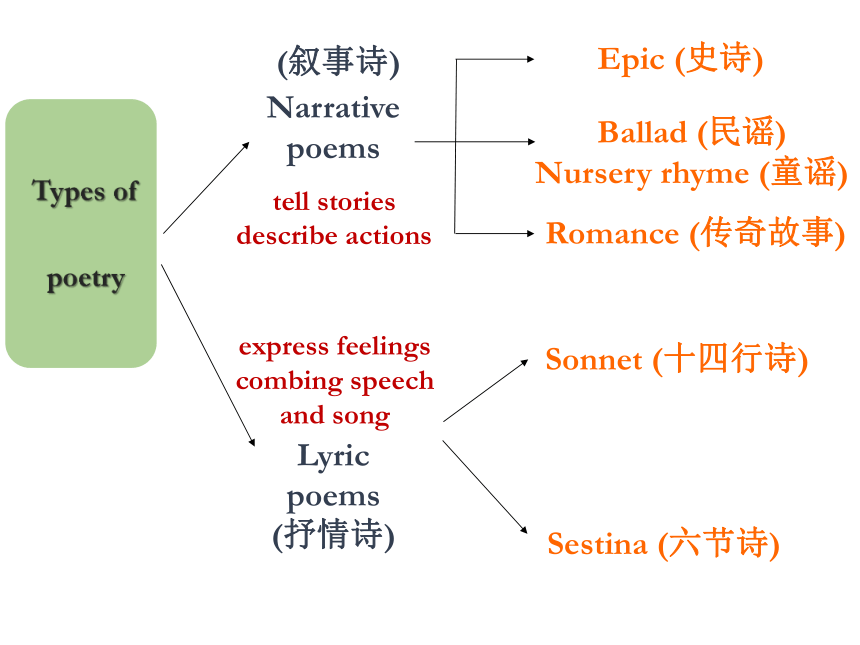
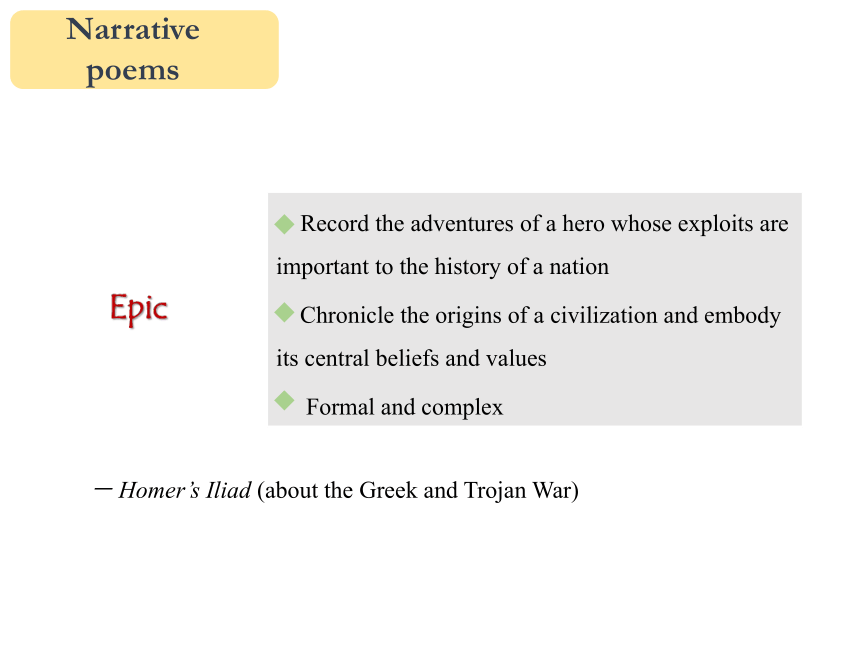
文档简介
(共10张PPT)
Unit 4 Exploring poetry
Welcome to the unit & Reading (I)
A brief introduction to the types and features of poetry
There is no universal definition of poetry.
Poetry is universally agreed to be more intense with feelings than other types of literature. It is the true language of emotion.
Features of poetry
Narrative poems
Lyric poems (抒情诗)
Epic (史诗)
Romance (传奇故事)
Types of poetry
Ballad (民谣)
Nursery rhyme (童谣)
Sonnet (十四行诗)
Sestina (六节诗)
tell stories
describe actions
express feelings combing speech and song
(叙事诗)
Narrative poems
Record the adventures of a hero whose exploits are important to the history of a nation
Chronicle the origins of a civilization and embody its central beliefs and values
Formal and complex
Epic
- Homer’s Iliad (about the Greek and Trojan War)
Narrative poems
Originally meant to be sung or recited
Passed on orally, only to be written down much later
Ballad
Narrative poems
Nursery rhyme
Rhyme and have strong rhythm
Have a lot of repetition
Are easy to learn and recite
Mary had A Little Lamb
It’s fleece was white as snow.
And everywhere that Mary went
The lamb was sure to go.
It followed her to school one day,
That was against the rule.
It made the children laugh and play
To see a lamb at school.
Narrative poems
Romance
Adventure is a central feature
Complex plots
Main characters are human beings who often confront
monsters, dragons and disguised animals
Lyric poems
The sonnet is a fixed verse form of Italian origin consisting of 14 lines that are typically 5-foot iambics rhyming according to a prescribed scheme.
- Sonnet 18 by William Shakespeare
The sestina consists of six stanzas (诗节) of six lines followed by a three-line conclusion. It requires a strict pattern of repetition of six key words that end the lines of the first stanza.
- A Miracle for Breakfast by Elizabeth Bishop
Unit 4 Exploring poetry
Welcome to the unit & Reading (I)
A brief introduction to the types and features of poetry
There is no universal definition of poetry.
Poetry is universally agreed to be more intense with feelings than other types of literature. It is the true language of emotion.
Features of poetry
Narrative poems
Lyric poems (抒情诗)
Epic (史诗)
Romance (传奇故事)
Types of poetry
Ballad (民谣)
Nursery rhyme (童谣)
Sonnet (十四行诗)
Sestina (六节诗)
tell stories
describe actions
express feelings combing speech and song
(叙事诗)
Narrative poems
Record the adventures of a hero whose exploits are important to the history of a nation
Chronicle the origins of a civilization and embody its central beliefs and values
Formal and complex
Epic
- Homer’s Iliad (about the Greek and Trojan War)
Narrative poems
Originally meant to be sung or recited
Passed on orally, only to be written down much later
Ballad
Narrative poems
Nursery rhyme
Rhyme and have strong rhythm
Have a lot of repetition
Are easy to learn and recite
Mary had A Little Lamb
It’s fleece was white as snow.
And everywhere that Mary went
The lamb was sure to go.
It followed her to school one day,
That was against the rule.
It made the children laugh and play
To see a lamb at school.
Narrative poems
Romance
Adventure is a central feature
Complex plots
Main characters are human beings who often confront
monsters, dragons and disguised animals
Lyric poems
The sonnet is a fixed verse form of Italian origin consisting of 14 lines that are typically 5-foot iambics rhyming according to a prescribed scheme.
- Sonnet 18 by William Shakespeare
The sestina consists of six stanzas (诗节) of six lines followed by a three-line conclusion. It requires a strict pattern of repetition of six key words that end the lines of the first stanza.
- A Miracle for Breakfast by Elizabeth Bishop
同课章节目录
- Unit 1 Food matters
- Welcome to the unit
- Reading
- Grammar and usage
- Integrated skills
- Extended reading
- Project
- Unit 2 The Universal Language
- Welcome to the unit
- Reading
- Grammar and usage
- Integrated skills
- Extended reading
- Project
- Unit 3 The art of painting
- Welcome to the unit
- Reading
- Grammar and usage
- Integrated skills
- Extended reading
- Project
- Unit 4 Exploring poetry
- Welcome to the unit
- Reading
- Grammar and usage
- Integrated skills
- Extended reading
- Project
